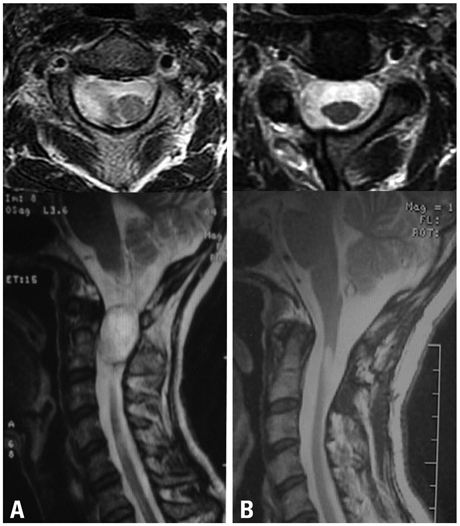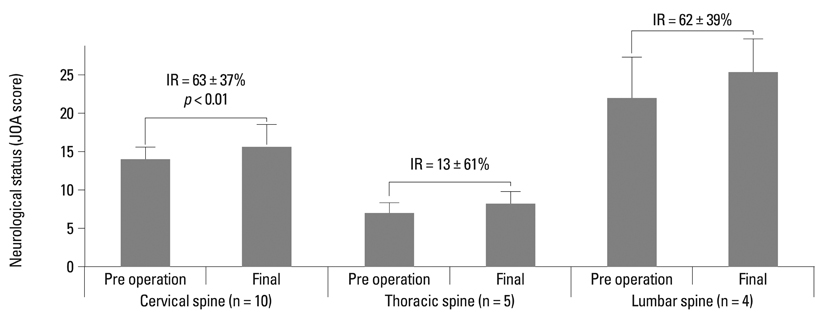Yonsei Med J.
2011 Jan;52(1):121-129. 10.3349/ymj.2011.52.1.121.
Hemilaminectomy for Removal of Extramedullary or Extradural Spinal Cord Tumors: Medium to Long-Term Clinical Outcomes
- Affiliations
-
- 1Department of Orthopaedic Surgery, Gifu University Graduate School of Medicine, Gifu, Japan.
- 2Department of Reconstructive Surgery for Spine, Bone, and Joint, Gifu University Graduate School of Medicine, Gifu, Japan. kei@bg8.so-net.ne.jp
- KMID: 1106446
- DOI: http://doi.org/10.3349/ymj.2011.52.1.121
Abstract
- PURPOSE
Laminectomy is generally the treatment of choice for removal of spinal tumors. However, it has been shown that laminectomy may cause instability due to damage of posterior elements of the spinal column, which may induce subsequent kyphosis in the future. Therefore, to reduce the risk of deformity and spinal instability after laminectomy, hemilaminectomy has been used. However, the medium to long-term effects of hemilaminectomy on spinal sagittal alignment is not well understood. The present study was performed to evaluate the clinical outcomes, including spinal sagittal alignment of patients, associated with spinal cord tumors treated by surgical excision using hemilaminectomy.
MATERIALS AND METHODS
Twenty hemilaminectomy operations at our institute for extramedullary or extradural spinal cord tumors in 19 patients were evaluated retrospectively with an average follow-up of 85 months (range, 40-131 months). Neurological condition was evaluated using the improvement ratio of the Japanese Orthopaedic Association Score (JOA score) for cervical, thoracic myelopathy, or back pain, and sagittal alignment by sagittal Cobb angle of the hemilaminectomied area.
RESULTS
The mean improvement ratio of neurological results was 56.7% in the cervical spine (p < 0.01, n = 10), 26.3% in the thoracic spine (not significant, n = 5), and 48.6% in the lumbar spine (NS, n = 5). The sagittal Cobb angle was 4.3 +/- 18.0degrees in the preoperative period and 5.4 +/- 17.6degrees at the latest follow-up, indicating no significant deterioration.
CONCLUSION
Hemilaminectomy is useful for extramedullary or extradural spinal cord tumors in providing fair neurological status and restoration of spinal sagittal alignment in medium to long-term follow-up.
Keyword
MeSH Terms
Figure
Reference
-
1. Eggert HR, Scheremet R, Seeger W, Gaitzsch J. Unilateral microsurgical approaches to extramedullary spinal tumours. Operative technique and results. Acta Neurochir (Wien). 1983. 67:245–253.2. Raimondi AJ, Gutierrez FA, Di Rocco C. Laminotomy and total reconstruction of the posterior spinal arch for spinal canal surgery in childhood. J Neurosurg. 1976. 45:555–560.
Article3. Yasuoka S, Peterson HA, Laws ER Jr, MacCarty CS. Pathogenesis and prophylaxis of postlaminectomy deformity of the spine after multiple level laminectomy: difference between children and adults. Neurosurgery. 1981. 9:145–152.
Article4. Bradford DS. Spinal instability: orthopedic perspective and prevention. Clin Neurosurg. 1980. 27:591–610.
Article5. Cattell HS, Clark GL Jr. Cervical kyphosis and instability following multiple laminectomies in children. J Bone Joint Surg Am. 1967. 49:713–720.
Article6. Panjabi MM, White AA 3rd. Basic biomechanics of the spine. Neurosurgery. 1980. 7:76–93.
Article7. Reimer R, Onofrio BM. Astrocytomas of the spinal cord in children and adolescents. J Neurosurg. 1985. 63:669–675.
Article8. Bertalanffy H, Mitani S, Otani M, Ichikizaki K, Taya S. Usefulness of hemilaminectomy for microsurgical management of intraspinal lesions. Keio J Med. 1992. 41:76–79.
Article9. Chiou SM, Eggert HR, Laborde G, Seeger W. Microsurgical unilateral approaches for spinal tumour surgery: eight years' experience in 256 primary operated patients. Acta Neurochir (Wien). 1989. 100:127–133.
Article10. Oleshkevich FV, Rozhanets NI, Volkovets NN. [Hemilaminectomy in the removal of spinal cord tumors]. Zh Vopr Neirokhir Im N N Burdenko. 1988. 30–32.11. Sario-glu AC, Hanci M, Bozkuş H, Kaynar MY, Kafadar A. Unilateral hemilaminectomy for the removal of the spinal space-occupying lesions. Minim Invasive Neurosurg. 1997. 40:74–77.
Article12. Oktem IS, Akdemir H, Kurtsoy A, Koç RK, Menkü A, Tucer B. Hemilaminectomy for the removal of the spinal lesions. Spinal Cord. 2000. 38:92–96.
Article13. Hosono N, Yonenobu K, Ono K. [Japanese Orthopedic Association: Scoring system for cervical myelopathy]. J Jpn Orthop Assoc. 1994. 68:490–503.14. Yonenobu K, Abumi K, Nagata K, Taketomi E, Ueyama K. Interobserver and intraobserver reliability of the japanese orthopaedic association scoring system for evaluation of cervical compression myelopathy. Spine (Phila Pa 1976). 2001. 26:1890–1894.
Article15. Yonenobu K, Ebara S, Fujiwara K, Yamashita K, Ono K, Yamamoto T, et al. Thoracic myelopathy secondary to ossification of the spinal ligament. J Neurosurg. 1987. 66:511–518.
Article16. Fujimura Y, Nishi Y, Nakamura M, Toyama Y, Suzuki N. Long-term follow-up study of anterior decompression and fusion for thoracic myelopathy resulting from ossification of the posterior longitudinal ligament. Spine (Phila Pa 1976). 1997. 22:305–311.
Article17. Ohnishi K, Miyamoto K, Kanamori Y, Kodama H, Hosoe H, Shimizu K. Anterior decompression and fusion for multiple thoracic disc herniation. J Bone Joint Surg Br. 2005. 87:356–360.
Article18. Miyakoshi N, Abe E, Shimada Y, Okuyama K, Suzuki T, Sato K. Outcome of one-level posterior lumbar interbody fusion for spondylolisthesis and postoperative intervertebral disc degeneration adjacent to the fusion. Spine (Phila Pa 1976). 2000. 25:1837–1842.
Article19. Yorimitsu E, Chiba K, Toyama Y, Hirabayashi K. Long-term outcomes of standard discectomy for lumbar disc herniation: a follow-up study of more than 10 years. Spine (Phila Pa 1976). 2001. 26:652–657.20. Asazuma T, Nakamura M, Matsumoto M, Chibo K, Toyama Y. Postoperative changes of spinal curvature and range of motion in adult patients with cervical spinal cord tumors: analysis of 51 cases and review of the literature. J Spinal Disord Tech. 2004. 17:178–182.
Article21. Parkinson D. Replacement laminotomy. Surg Neurol. 1977. 8:277–279.22. Bickham WS. III. Technique of Exposure of the Spinal Cord and Canal; Osteoplastic Resection and Laminectomy. Ann Surg. 1905. 41:372–398.
Article23. Ozawa H, Kokubun S, Aizawa T, Hoshika T, Kawahara C. Spinal dumbbell tumors: an analysis of a series of 118 cases. J Neurosurg Spine. 2007. 7:587–593.
Article
- Full Text Links
- Actions
-
Cited
- CITED
-
- Close
- Share
- Similar articles
-
- Profiles of Spinal Cord Tumors Removed through a Unilateral Hemilaminectomy
- Removal of Intradural-Extramedullary Spinal Cord Tumors with Unilateral Limited Laminectomy
- Radiological assessment of spinal cord tumor by myelographic finding
- Extraosseous Extradural Cervical Tuberculoma
- Surgical Results after Unilateral Laminectomy for the Removal of Spinal Cord Tumors



